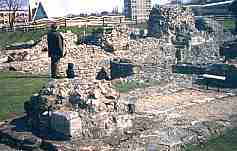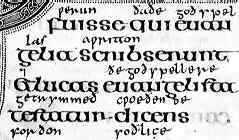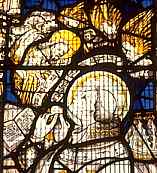



If you are looking at this page without frames, there is more information about medieval writing to be found by going to the home page (framed) or the site map (no frames).
| Literacy and the Church (3) | ||||
| Until around the 12th century most books were produced in monastic scriptoria. The need to build up increasing numbers of monastic libraries entailed much lending of books for copying. The work was undoubtedly laborious. Many scribe's colophons confirm this. Was the scribe a truly literate person, or a highly technically skilled craftsman with developed visual and motor skills? |  |
|||
| The ruins of St Augustine's Abbey, Canterbury, one of the early centres of book production. | ||||
| Certainly there are errors and corrections in the work of scribes, and the combined value of the materials and the labour of the scribe ensures that these are preserved. We have the luxury these days of obliterating our errors utterly. These don't really tell us much, except that scribes sometimes got tired and became inaccurate. | ||||
| The work of book production did not just entail the mechanical copying of a set of known and established texts. Even with the most fundamental works, glosses were produced for translation or commentary. | ||||
 |
The 7th century Lindisfarne Gospel (British Library, Cotton Nero D IV, f.5) has a 10th century interlinear Old English gloss inserted. Spot the godspellere above the Latin word evangelista. By permission of the British Library. | |||
| The above example shows a simple interlinear gloss, but glosses sometimes occupied more of the page than the original text, and were often transcribed along with the original work. The work was not something just learned orally, but something read, commented upon, discussed and the commentary preserved for future contemplation. This is a literate, scholarly tradition. | ||||
| The monasteries also produced their own original authors who produced annals and chronicles, religious commentaries and who assembled the works of others into compendia of knowledge. The words just proliferated. By the 13th and 14th centuries the concise histories of Bede had become the garrulous gossip of Matthew Paris with tales of abbots drinking themselves to death and suchlike. The ancient works of the fathers had gathered various accretions and interpretations to become bestiaries, encyclopedias and volumes on the lives of saints. The works of the church thinkers were reproduced, annotated and incorporated into the functioning of the institution. The answers given by the pope to questions of canon law were reproduced in volumes of decretals. |  |
|||
| Segment from a 9th century copy of the Historia Ecclesiastica of Bede (British Library, Cotton Tiberius C II), by permission of the British Library. | ||||
| The development of the universities in the 13th century put Latin literacy in both reading and writing into the heart of clerical education. Students copied texts by dictation or copied out their own textbooks through the pecia system. University texts were massively glossed as generations of scholars added their contributions to the corpus of knowledge. (See Pollard 1978) | ||||
| By the later middle ages the church was also participating in the literate conduct of its legal and administrative affairs. Rights granted by charter were preserved in cartularies. The various office holders in monasteries were keeping detailed written accounts. (See Tillotson 1988) Their affairs were being conducted in a literate mode. In the early middle ages, monastic scribes may have acted for the monarch in the production of legal documents. The proliferation of chancery scribes and literate officials at all levels of government made this unnecessary, but the village priest of the later middle ages probably still acted as an agent of literacy among the illiterate of his flock. | ||||
| It is intriguing that as the medieval era progressed, more and more detail was written in the works of church liturgy. Instead of a series of prompts, the entire text of the mass and the divine office was written in the missal and the breviary. This may suggest that learning the daily ritual was itself becoming more based in reading literacy and less in prodigious feats of memory. |  |
|||
| A depiction of the mass in a 15th century stained glass window in All Saints, North Street, York. Note the open book in front of the priest. | ||||
| Every monk was probably not a scribe at any time in the history of the church. Every priest may not have been an author or scholar. However, literacy, and Latin literacy at that, became the engine which drove the church. | ||||
|
|
||||
|
|
||||
|
If you are looking at this page without frames, there is more information about medieval writing to be found by going to the home page (framed) or the site map (no frames). |
||||